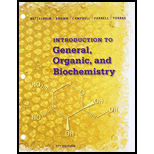
Concept explainers
Interpretation:The reason for the difference in anabolism and catabolism pathways should be explained.
Concept Introduction: All metabolic reactions in living bodies can occur in two ways; anabolic reactions and catabolic reactions.
Answer to Problem 29.1P
Both catabolic and anabolic pathways mostly different because they need entirely different set of enzymes for each step. Enzymes are very specific for substrate and reactions conditions so both pathways are quite different.
Explanation of Solution
A biochemical process due to which an organism lives, adapt, heat and reproduce is known as
Catabolism is the process in which complex molecules are break down to form smaller molecules. The energy is released in the process which is used by organisms.
The anabolism process needs energy and catabolism releases energy. These metabolic processes are regulated by hormones. The hormones that regulates anabolism are testosterone, estrogen, growth hormone and insulin etc. and the hormones that regulates catabolism are cortisol, cytokines, glucagon and adrenaline etc. In the metabolic pathways; both catabolic and anabolic pathways mostly different as they need entirely different set of enzymes with different steps of conversion. Therefore, they are different from each other.
Catabolism and anabolism involve different steps of conversions with different enzymes and energy. Therefore, they are mostly different.
Want to see more full solutions like this?
Chapter 29 Solutions
Bundle: Introduction to General, Organic and Biochemistry, 11th + OWLv2, 4 terms (24 months) Printed Access Card
 Chemistry: Matter and ChangeChemistryISBN:9780078746376Author:Dinah Zike, Laurel Dingrando, Nicholas Hainen, Cheryl WistromPublisher:Glencoe/McGraw-Hill School Pub Co
Chemistry: Matter and ChangeChemistryISBN:9780078746376Author:Dinah Zike, Laurel Dingrando, Nicholas Hainen, Cheryl WistromPublisher:Glencoe/McGraw-Hill School Pub Co General, Organic, and Biological ChemistryChemistryISBN:9781285853918Author:H. Stephen StokerPublisher:Cengage Learning
General, Organic, and Biological ChemistryChemistryISBN:9781285853918Author:H. Stephen StokerPublisher:Cengage Learning Organic And Biological ChemistryChemistryISBN:9781305081079Author:STOKER, H. Stephen (howard Stephen)Publisher:Cengage Learning,
Organic And Biological ChemistryChemistryISBN:9781305081079Author:STOKER, H. Stephen (howard Stephen)Publisher:Cengage Learning, Chemistry for Today: General, Organic, and Bioche...ChemistryISBN:9781305960060Author:Spencer L. Seager, Michael R. Slabaugh, Maren S. HansenPublisher:Cengage Learning
Chemistry for Today: General, Organic, and Bioche...ChemistryISBN:9781305960060Author:Spencer L. Seager, Michael R. Slabaugh, Maren S. HansenPublisher:Cengage Learning Introduction to General, Organic and BiochemistryChemistryISBN:9781285869759Author:Frederick A. Bettelheim, William H. Brown, Mary K. Campbell, Shawn O. Farrell, Omar TorresPublisher:Cengage Learning
Introduction to General, Organic and BiochemistryChemistryISBN:9781285869759Author:Frederick A. Bettelheim, William H. Brown, Mary K. Campbell, Shawn O. Farrell, Omar TorresPublisher:Cengage Learning





